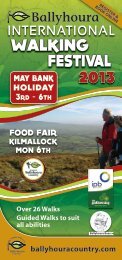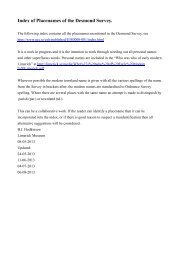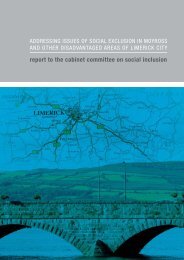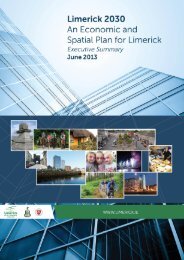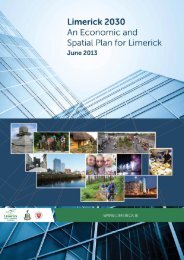An Economic and Spatial Plan for Limerick Appendices
An Economic and Spatial Plan for Limerick Appendices
An Economic and Spatial Plan for Limerick Appendices
You also want an ePaper? Increase the reach of your titles
YUMPU automatically turns print PDFs into web optimized ePapers that Google loves.
<strong>Limerick</strong> 2030 <strong>An</strong> <strong>Economic</strong> <strong>and</strong> <strong>Spatial</strong> <strong>Plan</strong> <strong>for</strong> <strong>Limerick</strong><br />
In 2011 the proportion of the Mid-West work<strong>for</strong>ce employed in Manufacturing had fallen to 14%,<br />
whilst the proportion of employment in construction had plummeted to 5%. There<strong>for</strong>e the proportion<br />
of the work<strong>for</strong>ce in vulnerable sectors in 2011 totalled 19%. Industries that had increased their<br />
proportion of total employment between 2006 <strong>and</strong> 2011 included the Public Sector (+5%), Business<br />
Services (+1%) <strong>and</strong> Wholesale & Retail (+1%).<br />
Table 5 below shows the current sector mix in the City, County <strong>and</strong> Mid-West compared to the State<br />
as a whole. Clearly, construction <strong>and</strong> manufacturing still have an above average dominance within<br />
the Mid-West economy. Industries that are less dominant than at the national level include wholesale<br />
& retail, business services <strong>and</strong> the public sector.<br />
The City is in contrast to the Region <strong>and</strong> has an employment structure that is more similar to the<br />
State, with a higher proportion of employment in business services <strong>and</strong> the private sector, although<br />
the public sector is still the dominant employer. Away from the public sector, the majority of<br />
employment in the City is in wholesale & retail (18%), business services (13%) <strong>and</strong> manufacturing<br />
(12%). The City also has a higher than average proportion of employment in restaurants &<br />
accommodation <strong>and</strong> transport & communication. In 2011, 15% of employment in the City was in<br />
vulnerable sectors compared to 21% at the County level, 28% at the Regional level <strong>and</strong> 16% at the<br />
State level.<br />
Table 5: Employment Structure by Geography - 2011<br />
Sector City County Mid-West State<br />
Agriculture, Mining & Utilities 1% 9% 8% 6%<br />
Manufacturing 12% 15% 17% 11%<br />
Construction 3% 6% 11% 5%<br />
Wholesale & Retail 18% 14% 13% 15%<br />
Restaurants & Accommodation 9% 5% 5% 6%<br />
Transport & Communication 7% 5% 6% 5%<br />
Business Services 13% 10% 10% 15%<br />
Public Sector 24% 31% 21% 31%<br />
Other/Not Stated 12% 8% 9% 10%<br />
Total 100% 100% 100% 100%<br />
Source: Census 2011<br />
Across all sectors of the City economy, with the exception of education, employment has declined<br />
in real terms. The aggregate fall in employment between 2006 <strong>and</strong> 2011 was 5,479, a proportional<br />
decline of almost 23%.<br />
The City has experienced significant structural adjustment since 2006. Levels of employment in<br />
manufacturing (-2,522) <strong>and</strong> construction (-1,061) have fallen dramatically <strong>and</strong> in 2011 made up a<br />
much smaller proportion of total employment than in 2006. Conversely the proportions of<br />
employment in the public sector, wholesale & retail <strong>and</strong> restaurants & accommodation have<br />
June 2013 22




